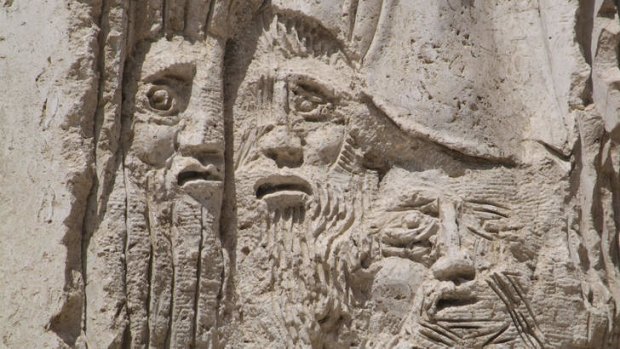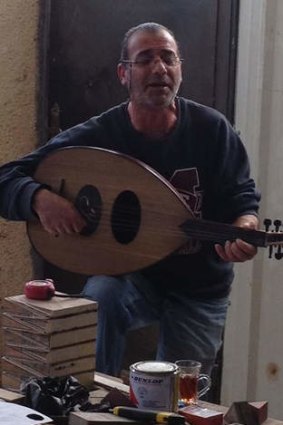By Tim Richards

Carvings at Mount Nebo, Jordan.Credit: iStock
Like Moses, I'm standing atop Mount Nebo, hoping for a glimpse of the Promised Land. Though he never reached it, at least the prophet had good viewing weather: according to the Bible, he saw ''the whole land … as far as the Mediterranean Sea''.
From the lookout, all I can see are dry, stony hills and a dusty horizon that obscures all details beyond a few kilometres. According to signs at the lookout, I should be able to see Jericho and even Jerusalem, with the Dead Sea even nearer, but the haze has consigned them to the imagination.
So I step inside the adjacent museum, an attractive structure of rough stone walls, next to a church built around the remains of a 6th-century Byzantine basilica. The church is out of bounds due to renovations, so I'm relying on the museum to give me a glimpse of the famous mosaics of the area.

A worker plays the oud outside Madaba.Credit: Tim Richards
Today it's packed with noisy schoolgirls on a day trip from the Jordanian capital, Amman, some of whom insist on taking a photo of me in my Indiana Jones-style hat.
Some exhibits are mosaics mounted on boards, many featuring Greek text. I'm particularly taken with one depicting a red-and-gold vase, from which hang bunches of grapes. The art is crude and misshapen, with stone blocks of varying sizes and a flat two-dimensionality. Strangely, however, that seems the attraction. You can see instantly that this was put together by hand, and feel a link with the creator. Then I move on to a large photographic reproduction of the chapel's mosaic floor, featuring a variety of animals from the region (including an unlikely spotted camel), and the link is lost.
That's the problem with museums. Orderly, well-lit, heavily captioned, they encourage the viewer to see every exhibit from an intellectual perspective. Even when the item on display was created as a piece of art, there's little to encourage you to see it that way, to reflect upon or be moved by its beauty. Lacking context, we follow the lead of the Victorians, who saw museums as places of education rather than rapture.
That perception melts a little when I reach the Church of the Map at nearby Madaba.
In a story familiar to this region, the original church was destroyed by an earthquake in the 8th century, its ruins lying hidden for more than a millennium before a Greek Orthodox church was built around the rediscovered remnants. What remains from the original is a remarkable floor-width mosaic map of the Holy Land, created by monks who deployed many thousands of stone pieces to depict towns, trees and animals, along with ancient Greek place names.
Standing above it, my eye is drawn to a lion chasing a gazelle towards the Dead Sea, on which people are floating in boats. Above this is a depiction of hilltop Karak, many centuries before it gained its famous Crusader castle, and below is a jumble of buildings representing Jerusalem. At the far right, past a pillar, are the branches of the Nile. I'm yearning to see the monks' interpretation of the Pyramids, but sadly, the mosaic runs out below the Nile Delta.
This map wrapped within a church is a fascinating fusion of the skills of map maker and artist. It's a reminder that the word ''art'' means more than the products of creativity, extending to skills and methodology.
It's hard to judge the mosaic's purely artistic merit, altered as it is by centuries of burial. But I'm still drawn to it, as a connection with the minds of the people who pieced it together 15 centuries ago. The final piece in my own mental mosaic clicks into place at a handicraft centre outside the city, one of those barn-like places tour buses visit.
In the workshop off the main showroom, I watch a man as he cuts squares of stone from longer rods, then places them carefully into a mosaic, which will depict the ancient Tree of Life design from Jericho.
There's an aura of calm in the workshop, a sense of people concentrating on a complex task and working methodically, rather than hastily. On the other side of the centre, a worker has downed tools and picked up an oud, the traditional Arabic stringed instrument. He's playing unselfconsciously above a table littered with craft knives and cardboard boxes, as people crowd through the doorway into his workshop to hear the music.
A mosaic of notes joins the mosaics of stone. It feels like art to me.
■ Tim Richards travelled courtesy of the Jordan Tourism Board.
Sign up for the Traveller newsletter
The latest travel news, tips and inspiration delivered to your inbox. Sign up now.